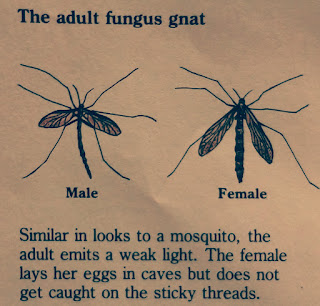FOR WHAT REASON DO GLOWWORMS SPARKLE?
Glowworms of australia and new zealand are not worms by any stretch of the imagination. they are the hatchlings of growth gnats. in their larval stage which most recent 10 months, the bugs seem as though inch-long worms and live in rounded sheaths that they fabricate and append to buckle roots, riverbanks, and fallen logs. The Glowworm is named for the light blue light it transmits from the tip of it's mid-region. it's light organs are toward the finish of the malpighian tubules, particular pieces of the wholesome channel, through which body squander passes. the light, sparkling persistently in the despair of caverns, draws in little bugs.
To trap the midges and flies it draws, every glowworm turns 20 to 30 silk strings, adds a tacky substance from its mouth, and drapes the strings from its sheath. a bug flying toward the Glowworm's light is probably going to find a hanging string and stick to it. when a bug is gotten, the glowworm pulls in the string and eats it's prey.
What is a glowworm?
glowworms have a place with the family Lampyridae. The insects in this gathering are usually known as fireflies or lightning bugs. There are north of 2,000 lampyrid species right now known to science. For the most part, the term glow-worm is applied to species where grown-up females look like their hatchlings (known as larviform females), are wingless and produce a consistent sparkle of light. The females' larval looks are logical why these scarabs are named as 'worms'.
Lampyris noctiluca is the glowworm species most frequently found in the UK. These nighttime insects, known as normal glowworms, are found across Europe and Asia. It very well may be interesting to tell normal gleam worm females and hatchlings separated, as the two of them have comparable looking sectioned bodies. In any case, the hatchlings have particular rosy spots outwardly edges of each section, which don't happen on grown-up females.
The hatchlings go after snails, though the grown-ups eat nothing. Grown-up females can stretch around 20 millimeters long. Guys can fly and are recognizable from females by the hard wing case covering their bodies and their far more modest size.
Placing on a light show
Grown-up female glowworms have an enormous, light-creating organ toward the finish of their midsections. Around evening time they utilize a splendid, constant flow of yellowish-green light to draw in flying guys. During the day they tunnel underground to keep away from hunters. A female will move to a high point, for example, a grass stem, and turn her sparkling light upwards. This guarantees that she is just about as noticeable as conceivable to flying guys. Grown-up female L. noctiluca only live for half a month, until they mate and lay their eggs.
Their lights are bioluminescent, which is the normal creation of light by an organism created by a compound response. In glowworm, a particle called luciferin is joined with oxygen to make oxyluciferin. A compound response with the light-transmitting protein luciferase produces their enlightenments. In any case, glowworms can only with significant effort control the stock of oxygen, so they can't streak their lights on and off like some other firefly species. Rather they produce a supported stream of light.
Femme fatale fireflies
In non-shine worm fireflies, guys and females convey by both blazing their lights in explicit examples and beats to recognize themselves. This is one of the principle ways for fireflies to let know if they're getting a message from similar animal types. Fireflies in the genus Photuris, found in North America, are regularly called femme fatale lightning bugs. The females emulate the light examples of different species, drawing in guys to kill and eat them
In types of firefly where the hatchlings gleam unmistakably, this is likely for safeguard. Their gleam might be being utilized to flag that they wouldn't be a wonderful dinner for hunters.
SHEATH BUILDING AND LINE HANGING
Every hatchling has a bodily fluid organ, which privileged insights a reasonable bodily fluid, and a silk organ, which twists string. the hatchling begins its sheath with a layer of bodily fluid, tying down it to the cavern rooftop with silk strings. Utilizing extra bodily fluid, the hatchling broadens its sheath to maybe multiple times it's body length. The hatchling hangs it's "fishing lines''.
Process Included
1. Inclining out of the sheath, the glowworm drops string and bodily fluid together.
2. Next the hatchling produces just string, bringing down the beads on the string.
3. The hatchling secretes bodily fluid again to add one more tacky dot to the string.
caught prey is pulled in by detecting vibration in one of it's hanging lines, the hatchling realizes when prey is gotten and where. The hatchling then, at that point, loosens up head first to follow the vibration string down. At the point when a big part of it's body inclines from the sheath, the Glowworm begins pulling in the string, holding the rolled-up line under it's body while loosening up for a new grasp. Whenever it has lifted the prey dependent upon it's mouth, the glowworm nibbles the bug and maneuvers it into the sheath.
4. taking the line in it's mouth, the hatchling starts to pull in it.
5. getting its front portion body, it pulls up the string.
6. pulling further, the glowworm surrounds it's prey.
LIFE STRUCTURES OF A GLOWWORM HATCHLINGS
* Bodily fluid organ
* Silk organ
* malpighian tubule
* iridescent organ.
The straightforward glowworm hatchling has separate silk and bodily fluid organs, which produce the string and tacky beads. Toward the finish of the mid-region four malpighian tubules structure a thick light-creating structure.


